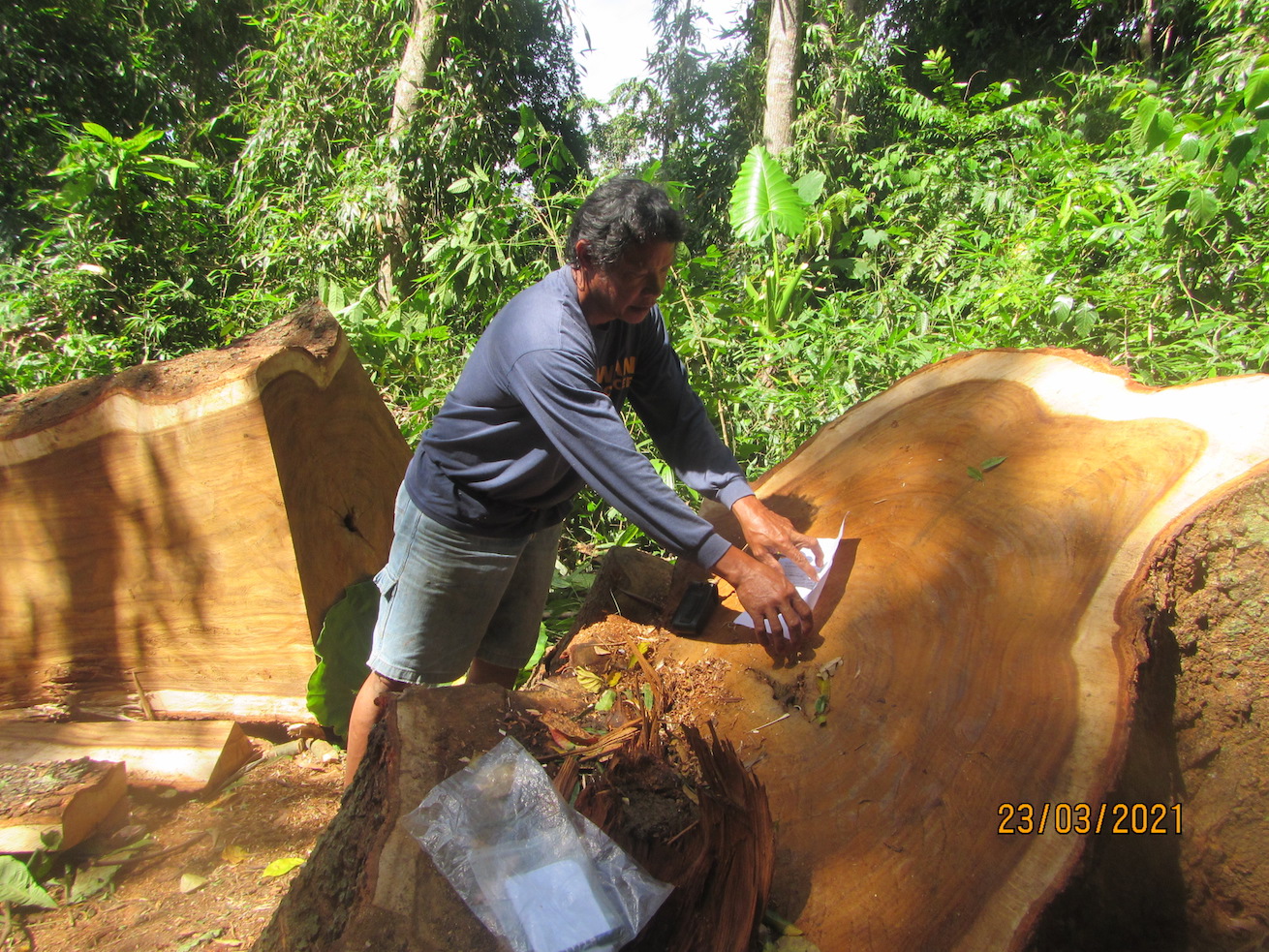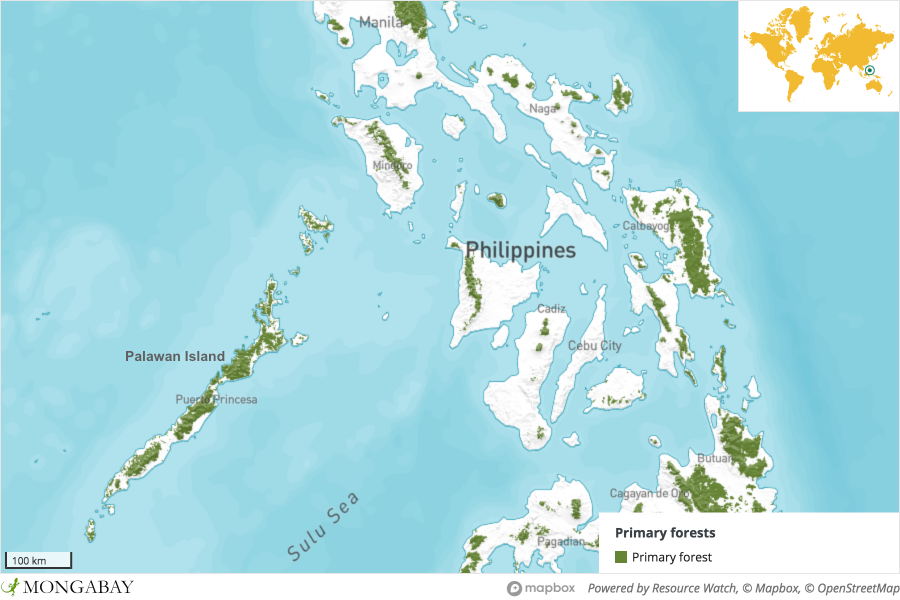- Since November 2020, Indigenous people have observed trees that have been illegally felled within a mining concession in southern Palawan, an island in the western Philippines.
- The forests are sacred to the Indigenous Pala’wan people, who have for decades fought against plans to mine the area.
- Against the backdrop of loosening restrictions on mining both nationally and locally, Pala’wan leaders and local NG0s say the logging could be a precursor for a resurgence of mining.
- The concession holder has denied any link to the illegal activity, while the government’s mining agency has said it wasn’t done at the company’s initiative.
Pala’wan indigenous community leader Simpio Mata trudges through the natural forest of Mount Domadoway, in the southern part of the Philippines’ Palawan province, at least twice a month. He does this primarily to check on the presence of towering trees the Pala’wan consider sacred homes for tau’t kekeywan (forest spirits). Recently, the 42-year-old Mata says he has been aghast to see felled trees.
According to Mata, local people are alarmed not just by the illegal logging, but also by what they fear the activity might signal: a resurgence of plans to mine the area, which the Pala’wan have been fighting against for decades.
The forest degradation is particularly apparent in Abukayan village in the town of Sofronio Espanola. This is where the limestone quarrying firm Pyramid Hill Mining and Industrial Corporation wants to operate after obtaining a mineral production sharing agreement with the government in 2001 despite fierce community resistance. The 25-year agreement covers a 5,149-hectare (12,723-acre) contract area rich in limestone and shale, but extraction plans were suspended after a mining ban was imposed in 2012.
The government’s Mines and Geosciences Bureau (MGB) confirmed to Mongabay that illegal tree cutting has occurred within Pyramid Hill’s contract area, saying it was first reported by its field office as early as November 2020. “The forestland clearing … is not government approved or Pyramid’s Initiative,” said MGB regional director Glenn Marcelo Noble. He added that the bureau has already formally reminded the mining firm of its responsibility to police its concession area.
“We are saddened by the report of illegal activities which may have harmed our environment,” Pyramid Hill’s parent company, investment holding company Premiere Horizon Alliance, said in a statement to Mongabay. “Rest assured that the Company will fully cooperate and give assistance in the prosecution of all involved once our permits to operate in the area are completed.”
Activists, however, are suspicious about the timing and location of the tree-felling. They note that the deforestation is concentrated within the mining concession, and comes at a time when the prospects for mining in Palawan look brighter than they have in years, largely due to deregulation efforts that officials are touting to revive the country’s economy after its battering by the COVID-19 pandemic. Provincial authorities are considering modifying guidelines about where in Palawan mining is permitted, and President Rodrigo Duterte in April lifted a nine-year nationwide moratorium on new mining permit issuances.

While there’s no evidence linking the deforestation to Pyramid Hill, Mata says that clearing the forest could ease the way for the stalled mining operation to finally push through.
“Once the forest is totally cleared, it could embolden the mining company to tell us, ‘what are you opposing for when there are no longer trees standing there?’” Mata told Mongabay.
The Palawan NGO Network (PNNI) expressed the same concerns, saying that illegal logging could be a prelude to extraction activities. Under Pyramid Hill’s contract, the company is prohibited to undertake mineral extraction in old-growth forests and other ecologically important areas currently closed to mining under Palawan’s laws. However, PNNI executive director Robert Chan told Mongabay that, “by showing that it is not a forested area anymore … it will be easier to get permits” from the Palawan Council for Sustainable Development (PCSD) and Department of Environment and Natural Resources (DENR).
Mata says the loss of the forest would be a disaster for the community.
The area around Mt. Domadoway is home to around 2,500 Pala’wan people from 12 rurunganen (villages). The Pala’wan community revere Domadoway so much so that they prohibit people from defecating or urinating anywhere on the mountain, particularly in a cave system they call Sambanon. “Doing so can get you into trouble with the tau’t kekeywan,” he said.
Protected under the Philippine caves law, Sambanon is where the Pala’wan take refuge when it rains while they’re foraging for edible wild plants. “So, when you go there, your motive should be pure; otherwise, the unseen people would know and punish you with sickness,” Mata said.
For them, Domadoway is a gift from the ancestors that keeps on giving, as besides wild food, medicinal herbs and water, they also rely on it for subsistence crops grown through swidden farming.
“If mining intrudes into our ancestral forestland, it can affect everything we value, especially our cultural traditions and customs,” Mata said.

Protected forests
From 1979 to 1984, Palawan lost its forests at a rate of 19,000 hectares (46,950 acres) per year, government data show. To reverse this trend, the Strategic Environmental Plan for Palawan (SEP) Act was introduced in 1992, when the province’s total forest cover stood at 789,488 hectares (1.95 million acres), down from 1.3 million hectares (3.2 million acres) in 1970.
The SEP imposed a province-wide commercial logging ban and designates natural forests, high-elevation areas, habitats of endangered species and other ecologically significant zones as “areas of maximum protection” or “core zones” in which all but traditional tribal activities are barred.
The SEP reduced but did not stop timber poaching, bringing the province’s annual deforestation rate down to 5,500 hectares (13,590 acres) starting from its passage up to 2010. As of 2015, the most recent year for which official figures are available, the province had just 694,000 hectares (1.7 million acres) of remaining forest cover.
Recently, the PCSD, the provincial environmental regulator, announced plans to review the criteria by which core and restricted zones are designated. The PCSD says the amendment aims to “reduce the restraints on many industries from operating in Palawan,” which activists view as a move to accommodate more mining projects.
“The spirit with which the SEP law was instituted is one of conservation and not utilization,” said the PNNI’s Chan, an environmental lawyer. “That is why its goal was to establish a total logging ban in Palawan. When this goal is not realized by the projects presently being pursued by the government, then something is amiss. Palawan is primarily an agricultural and tribal community, to transform it to a tourist and mining industry is to go against its culture and known heritage.”
PCSD executive director Teodoro Matta, however, says plans to update zoning are backed by evidence showing changes in Palawan’s environment.

Policy loophole
In 2008, the Palawan provincial government passed a 25-year moratorium on endorsement issuances for new mining applications. But it only covers small-scale mining firms, hence large-scale ones continue to operate.
Currently, more than 28,000 hectares (69,000 acres), or 1.89% of Palawan’s 1.5-million-hectare. (3.7-million-acre) total land area, are covered by mining tenements.
Existing mines have resulted in environmental damages that have impacted communities. The rampant law violations and the murder of a local broadcaster fueled a nationwide clamor to spare Palawan from mining, with the petition garnering 10 million signatures.
Some civil society observers say the end of the nationwide moratorium could put pressure on the provincial government to rescind its own mining moratorium.
Should the provincial government do so, mining would remain barred in primary forests, in accordance with a suite of laws including the Mining Act, Expanded National Integrated Protected Area Systems Act and Wildlife Resources Conservation and Protection Act. Duterte’s decision to repeal the mining moratorium does not supersede other environmental acts, notes Grizelda Mayo-Anda, an environmental law professor at Palawan State University and executive director of the nonprofit Environmental Legal Assistance Center.
According to the PCSD’s Matta, however, mining is permitted in areas designated as “controlled use zones,” which form the outer buffer for maximally protected areas; in cases where such zones may overlap with critical resources like intact forests or significant wildlife habitats, the PCSD’s decisions on allowable activities will rest on validation and data collection.

People and forests
The Philippine government’s pivot toward allowing more mining will undermine Indigenous peoples’ rights and increase the marginalization of some of the country’s most effective guardians of biodiversity, says University of Melbourne geographer and anthropologist Wolfram Dressler.
For centuries, Indigenous peoples have proactively and sustainably managed forests and lands, scientists say. “It’s no coincidence that Indigenous territory overlaps with the most biodiverse forest areas in the Philippines,” Dressler, who has conducted ethnographic studies on Pala’wan group, told Mongabay.
The same areas, however, are a magnet for the extractive industries. “Without protecting Indigenous rights to land and forests, there’s little hope for a sustainable, inclusive future. As COVID-19 has shown, the neoliberal growth paradigm that feeds mining … is highly flawed,” Dressler said.
“The outcome of Indigenous peoples on Palawan not being able to defend their ancestral lands from mining activities, whether small or large in scale, would be catastrophic for Indigenous rights and conserving forests across the island,” he added.
While the animistic Pala’wan believe that the tau’t kekeywan are powerful spirits that can guard Domadoway from external forces, Mata says times are changing and they will not leave the matter to fate. Determined to stand on their own, he said the Pala’wan will continue their struggle against mining.
“The thought that our mountain would be destroyed and our children couldn’t inherit it worries us,” said the Pala’wan leader, a father of two. “If only I could take the law into my hands, I would do that to stop it.”
FEEDBACK: Use this form to send a message to the author of this post. If you want to post a public comment, you can do that at the bottom of the page.